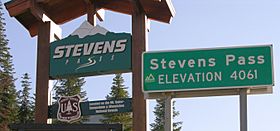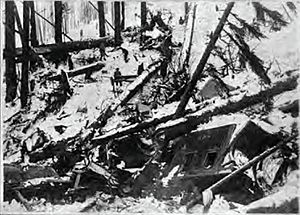Stevens Pass facts for kids
Quick facts for kids Stevens Pass |
|
|---|---|
 |
|
| Elevation | 4,061 ft (1,238 m) |
| Traversed by | U.S. Route 2 |
| Location | Chelan / King counties, Washington, United States |
| Range | Cascades |
| Coordinates | 47°44.7′N 121°5.6′W / 47.7450°N 121.0933°W |
Stevens Pass is a mountain pass in the Cascade Mountains in Washington, United States. It sits right on the border between King County and Chelan County. The pass is about 4,061 feet (1,238 meters) high.
U.S. Route 2 is a highway that goes right over Stevens Pass. The famous Pacific Crest Trail, a long hiking trail, also crosses the highway here. Deep below the pass, there's a long train tunnel called the Cascade Tunnel, used by the BNSF Railway.
Near Stevens Pass, you'll find the Stevens Pass Ski Area. This popular ski resort is located on two mountains: Cowboy Mountain and Big Chief Mountain.
Contents
Discovering Stevens Pass
Stevens Pass is named after John Frank Stevens. He was the first non-Native American person to officially find and map the pass.
Early Knowledge of the Pass
Native Americans who lived in the area already knew about this pass. However, we don't know much about the exact routes they used through the mountains.
In 1872, a man named Hubert C. Ward was exploring for the Northern Pacific Railway. Native Americans told him about a low pass where Nason Creek met the Skykomish River. Later, in 1887, Albert Bowman Rogers of the Great Northern Railway also heard about this area from Native Americans. Neither explorer had enough time to fully check out the pass.
John Stevens' Survey
In 1890, John Stevens did a detailed survey for the Great Northern Railway. He found the pass and decided it was the best spot for a railway to cross the North Cascades. Stevens noted that there were no signs of trails or campsites. It seemed like the pass wasn't used much by people crossing the mountains. He wrote that people usually used Snoqualmie Pass to the south or Indian Pass to the north.
John Stevens also mapped out Marias Pass in Montana. This pass is near Glacier National Park.
Famous Avalanches
Stevens Pass has seen some very large and serious avalanches.
The Wellington Disaster (1910)
One of the worst train disasters in U.S. history happened here. On February 23, 1910, two Great Northern Railway trains got stuck at the Cascade Tunnel Station. A huge snowstorm and avalanches had blocked the tracks.
Six days later, on March 1, another massive avalanche struck. It pushed both trains about 150 feet (46 meters) down into the Tye River Valley. The trains were buried in snow and debris. This event, known as the Wellington Disaster, killed 96 people. This included 35 passengers and 61 railroad workers.
Tunnel Creek Avalanche (2012)
More than a century later, another serious avalanche happened near Tunnel Creek Canyon Road. This was on February 19, 2012. Three experienced backcountry skiers died in this avalanche. One of them was the marketing director for the Stevens Pass Ski Area.
A professional skier named Elyse Saugstad survived this avalanche. She was wearing a special avalanche airbag backpack. This backpack helped her survive after tumbling over 2,000 feet (600 meters) down the mountain.
Weather at Stevens Pass
Stevens Pass has a mountain climate that gets a lot of influence from the ocean. This means it has short, mild, and dry summers. Winters, however, bring extremely heavy snowfall.
The weather here is known as a subarctic climate. This type of climate has very cold winters and cool summers.


